Lisbon, Portugal’s most visited destination, is known for its stunning vistas, iconic vintage trams, and buildings adorned with blue ceramic tiles.
Four days is enough time to enjoy the city’s historic architecture, panoramic viewpoints, pleasant weather, and charming districts.
My sister and I separately visited Lisbon, and here, I share our practical travel tips and ways to optimize your itinerary. This post covers:
- ⭐️ Top things to do in Lisbon
- 🗓️ 4-day optimized itinerary
- 📍 Lisbon map with key places
- 🚙 How to get around Lisbon
- 🏠 Where to stay
Planning a trip? Here’s what to know about Portugal.
Lists By Lukiih is readers-supported. When you buy with my affiliate link, I may earn a small commission. Thanks!
Lisbon at a Glance
Before getting into the itinerary, here’s some general information on Lisbon to help you plan your trip.
🚋 What Is Lisbon Known For?
Lisbon is a big city and the capital of Portugal. It’s known for its vibrant and distinct neighborhoods, historic architecture, vintage trams, and cultural sites.
The Tagus River runs along Lisbon, so the city is known for its riverfront views and communities.
📍 Where Is Lisbon Located?
Lisbon is located on the western peninsula in the middle of Portugal, flanked by the Tagus River and the Atlantic Ocean.
Most visitors fly directly into Humberto Delgado Airport (LIS), Portugal’s primary international airport in Lisbon, to get to Lisbon.
🗓️ How Long To Spend in Lisbon?
Lisbon has several distinct areas to explore, so you’ll want to spend at least three days there. This is a good amount of time to see the city’s best attractions.
You can add additional days for any day trips you plan to take. Depending on your interests, you might get tired of the capital and want to go elsewhere around the fifth or sixth day.
See how to spend a week in Portugal.
☀️ Best Time To Visit Lisbon
Lisbon has a Mediterranean climate and is known to have pleasant, mild weather year-round.
Lisbon’s peak season is during the summer months, from June to August. The best time to visit is spring and fall to avoid the crowds and enjoy the nice weather.
Here’s a quick overview of Lisbon’s four seasons:
| Season | Months | Temperatures |
|---|---|---|
| Spring | Mar-May | 50-68 °F |
| Summer | Jun-Aug | 65-82 °F |
| Fall | Sep-Oct | 60-75 °F |
| Winter | Nov-Feb | 48-62 °F |
I visited in May, and my sister visited in September. We were both mostly wearing a light long jacket and long pants, but I could occasionally wear shorts and a short-sleeved top.
💰 Is Lisbon Expensive To Visit?
For being Portugal’s biggest and most visited city, Lisbon is semi-affordable to visit.
- Mid-range budget travelers can expect to spend about $110 a day in Lisbon.
- Budget travelers can expect to spend about $70 a day in Lisbon.
See my budget breakdown for my trip to Lisbon.
Getting Around Lisbon
Lisbon is home to Portugal’s primary international airport, Humberto Delgado Airport (LIS). Most visitors fly into Lisbon’s airport when traveling to the country.
From the Lisbon airport, you can take a 20-minute metro ride into the city’s center for less than $2 USD.
Once in Lisbon, you can get around by taking public transportation, calling a taxi/Uber, walking, or renting a car.
🚇 Option 1: Public Transportation
Lisbon’s extensive public transportation includes the metro, train, bus, and tram. Lisbon’s public transportation is clean and easy to navigate.
To ride Lisbon’s public transportation, you need to buy a Viva Viagem Card, which is available at the Lisbon airport and any metro station. You can charge it as you go, which is called “zapping” there.
You can also consider getting the Lisbon Card, which includes unlimited transport by metro as well as free admission to several of the city’s top attractions.
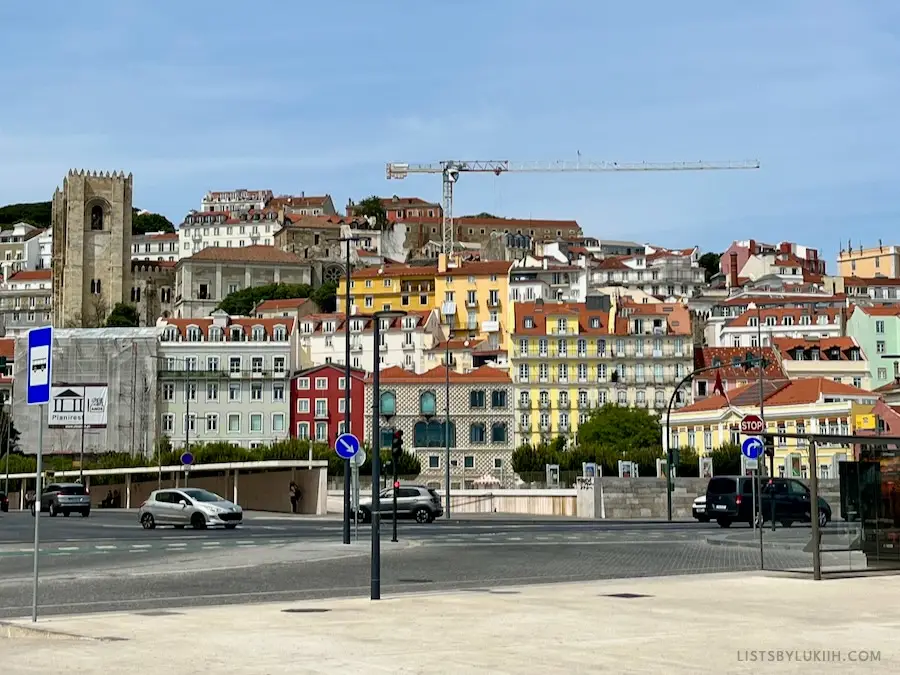
🚕 Option 2: Taxi or Uber
Uber and taxis are widely available in Lisbon. Taxi and ridesharing prices are similar, and both will be significantly more expensive than public transportation.
I used Uber three times in Lisbon to get to different districts that didn’t have convenient public transport options.
👟 Option 3: Walking
Lisbon is a pedestrian-friendly city that’s easy to explore on foot, especially once you get to each distinct district.
Like many other cities in Portugal, Lisbon is incredibly hilly, so make sure to wear comfortable shoes. I was happy in my running shoes and sneakers, while my sister wore Converse and had foot pain from all the walking.
🚗 Option 4: Rental Car
Given Lisbon’s great public transportation, renting a car makes sense only if you’re doing a more off-the-beaten-path itinerary.
You need a valid driver’s license and basic third-party liability insurance to rent a car in Portugal. Some rental insurances will have a 21 to 23 age requirement despite the legal driving age being 18.
Unlike in some other countries, tuk-tuks in Portugal are used primarily as vehicles for giving tours, not as transportation between points A and B. This is why Lisbon tuk-tuks are fairly expensive, costing around $30 an hour.
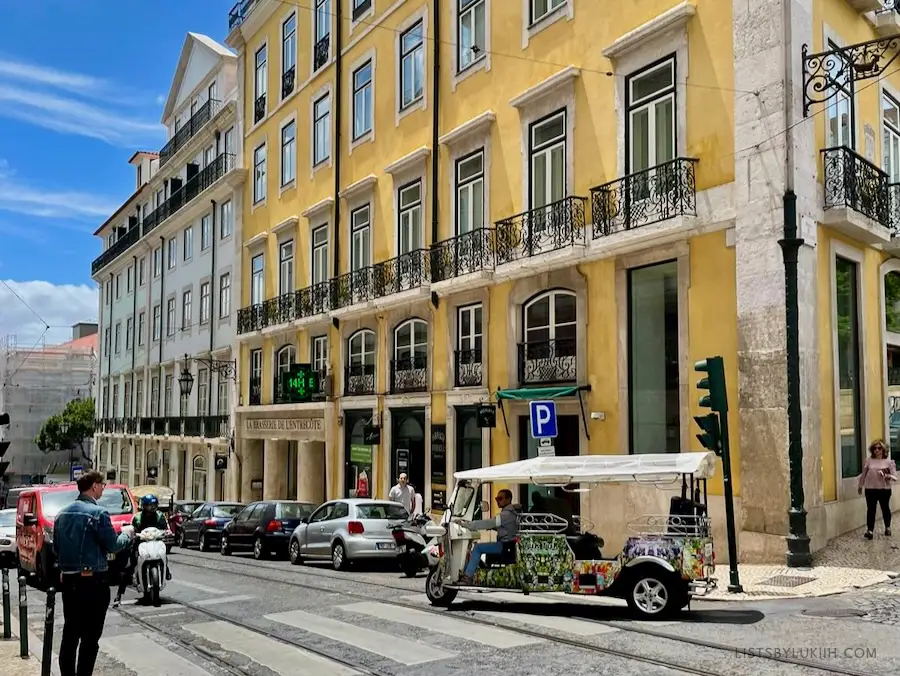
Lisbon Itinerary Map
This map has all the recommended places in the Lisbon travel itinerary below.
4-Day Lisbon Itinerary
This Lisbon itinerary efficiently sequences attractions and activities the city is famous for.
I’ve also included suggested times for each activity based on my and my sister’s firsthand experiences.
The Portugal trip planner below has this itinerary prefilled.
| Day 1 in Lisbon | ||
| ✈️ | Arrive in Lisbon and take the metro to the city center | Morning |
| 🚶🏻♀️ | See Baixa-Chiado’s top attractions | 1–5 pm |
| ☀️ | Visit a miradouro for sunset | 6–7 pm |
| 🍺 | Go to Pink Street for the nightlife | After 8 pm |
| Day 2 in Lisbon | ||
| 🦞 | Have lunch at Time Out Market Lisboa | 12–1:30 pm |
| 🚂 | Take the vintage tram to Belém | 2–2:30 pm |
| ⛪️ | Explore Belém | 2:30–6:30 pm |
| ☀️ | Visit another miradouro for sunset | 6–7 pm |
| 🍹 | Go to Bairro Alto for the nightlife | After 9 pm |
| Day 3 in Lisbon | ||
| 🏰 | Do a day trip to Sintra | All day |
| Day 4 in Lisbon | ||
| 😎 | Walk around LX Factory | Morning |
| 🚆 | Take the train to Porto | Afternoon |
10 Great Things To Do in Lisbon
Having collectively spent a week in Lisbon, I share my and my sister’s recommendations and honest opinions on the top attractions and activities below, listed in rough order of priority.
All prices mentioned here are in USD 💵 .
1. Take a Full-Day Trip to Sintra
🤔 Why: Sintra is the most popular day trip destination from Lisbon. It has a picturesque, walkable town center and some of Portugal’s most beautiful attractions.
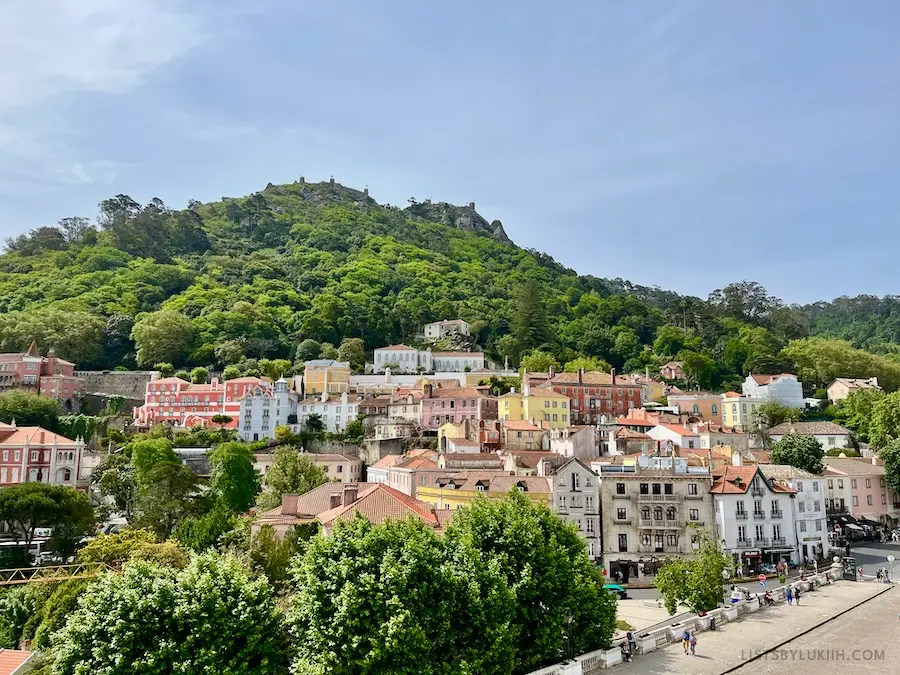
🌟 Top Attractions: Sintra has over 15 attractions, including castles, palaces, parks, towers and museums. The following are the best main attractions in Sintra:
- Pena Palace – one of the Seven Wonders of Portugal and Sintra’s #1 attraction. The colorful exterior and scenic view attract visitors from around the world.

- Castelo dos Mouros – the Moorish Castle that has panoramic views. Visitors like exploring its many steps and walls as well.
- Quinta da Regaleira – a Renaissance-style villa surrounded by a park-like garden that’s great to walk through. It’s also famous for the Initiation Well.
Learn how to plan a Sintra day trip in detail.
🚗 Getting There: Sintra is a 30 to 45-minute drive west of Lisbon. You can reach Sintra in three different ways:
- Sintra full-day tour – Tours typically include transportation. They start at $60 but are usually closer to $90 for highly-rated, English-speaking ones.
- Public transportation – This is the cheapest option, but also the most inconvenient as you’ll have to rely on the train to get to Sintra and then take the bus to get around.
- Uber – Taking an Uber or taxi from Lisbon to Sintra can cost over $100 round-trip, so it is only worth it if you can split it with a group, which is what my sister did.
💰 Expected Cost: A typical full-day Sintra tour costs roughly $80.
⏰ Suggested Duration: 1 to 2 days
It’s difficult to see many of Sintra’s top attractions during peak season, which is from June to August, as there will be long lines at each attraction.
🍀 Lukiih’s Take: Sintra was one of my Portugal trip’s highlights, and I wished I had spent more time there. You’ll feel similar if you enjoy taking photos (Sintra has many beautiful views and architecture) and have visited a good number of European cities (Sintra feels more unique than your typical historic city).
2. Spend Half a Day in Belém
🤔 Why: Lisbon’s Belém district hosts some of Portugal’s most notable monuments and buildings. The area holds historical and cultural significance and has several UNESCO World Heritage Sites.

🌟 Top Attractions: Belém has beautiful street art, several big parks and gardens, and colorful neighborhoods. The following are Belém’s top tourist attractions:
- Torre de Belém (Belem Tower) – a UNESCO World Heritage Site and one of Portugal’s most famous landmarks. The tower used to be on its own island, but an earthquake moved and merged it with the land. The interior has a $7 admission fee.

- Mostereiro dos Jerónimos (Jerónimos Monastery) – an architectural feat that took 100 years to complete. The monastery can be admired from both the outside and inside. The interior has a $13 admission fee.
Pastéis the nata, Portugal’s famous custard tarts, were invented by monks who lived in Jerónimos Monastery.

- Padrão dos Descobrimentos (Monument to the Discoveries) – a large sculpture by the Tagus River. It features some of Portugal’s historical explorers, artists, and inventors.

Belém is also famous for Pastéis de Belém, my sister’s favorite and my second favorite pastéis de nata shop.
🚗 Getting There: You can get to Belém by tram, train, bus, Uber or bike. You can also take a well-rated Belém walking tour to understand more of the district’s deep historical context.
- Uber – If you use Uber, get dropped off at Belém Tower and walk east along the Tagus River to see the attractions. My sister used Uber because she was able to split the cost of a ride between several people.
- Tram – Take Tram 15E and get off at the Mosteiro Jerónimos stop. This is what I did, and I found it easy to navigate.
💰 Expected Cost: The cost of visiting Belém depends on your transportation method and whether you plan to visit the interiors of attractions that have entrance fees. A visit can be as cheap as $6 or as expensive as $40 with a tour.
⏰ Suggested Duration: 3 to 5 hours. My sister and I separately spent approximately three hours in Belém.
🍀 Lukiih’s Take: Belém is a flat area in Lisbon, so it’s a great area to explore on foot. With its wide open spaces, parks, and gardens next to the Tagus River, Belém is also a great escape from the narrow streets of Lisbon’s city center.
3. Catch the Sunset at a Miradouro
🤔 Why: Miradouros are viewpoints in Lisbon that are typically located on the highest hills in the surrounding area. Visitors get a panoramic view of the city, and it’s particularly beautiful during sunsets.
🌟 Where To Go: Miradouros often have resting places that allow visitors to settle down and enjoy the view. Lisbon has over 30 miradouros, but some of the most scenic and popular ones are:
- Miradouro da Senhora do Monte – one of the best panoramic views in Lisbon. My sister took a special trip to visit this viewpoint, and it was her favorite one because you can see the buildings, water, and Moorish castle simultaneously.
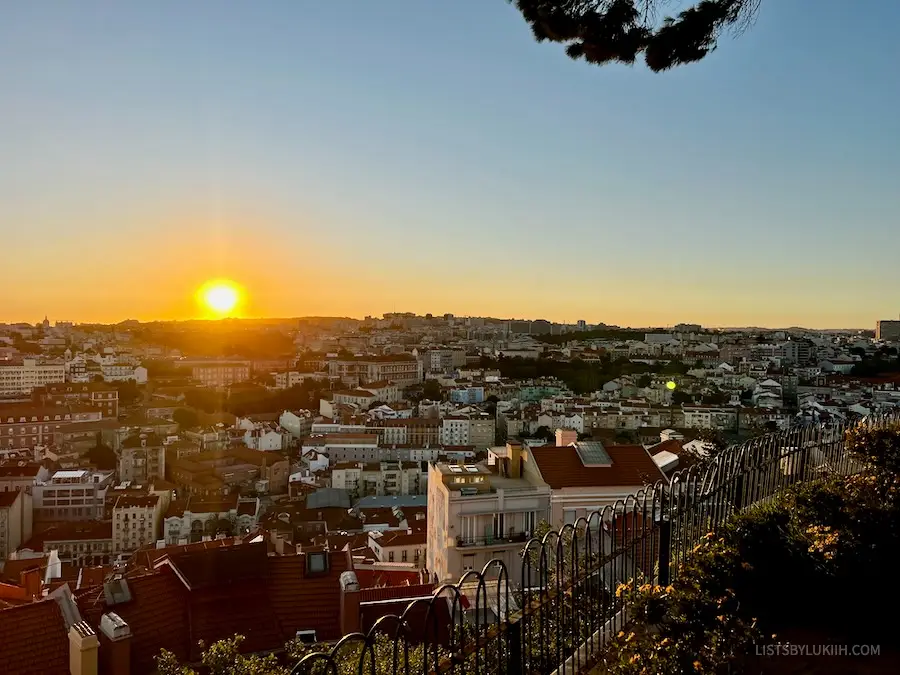
- Miradouro de São Pedro de Alcântara – has a beautiful view and is located in a nice garden. This is a great option if you want to venture into a less touristy part of Lisbon.
- Miradouro Castelo de São Jorge – the highest Lisbon viewpoint next to São Jorge castle. This is a good option if you plan to visit the Moorish castle. It closes at 7 pm daily, so you can only be there for a short time after sunset.
- Miradouro das Portas do Sol – known as one of the most popular viewpoints. It has a wide open terrace where several groups can enjoy the view at the same time.

- Miradouro de Santa Luzia – within walking distance of Miradouro das Portas do Sol. It has limited views with large crowds, but the terrace is beautifully adorned with plants and blue ceramic tiles.
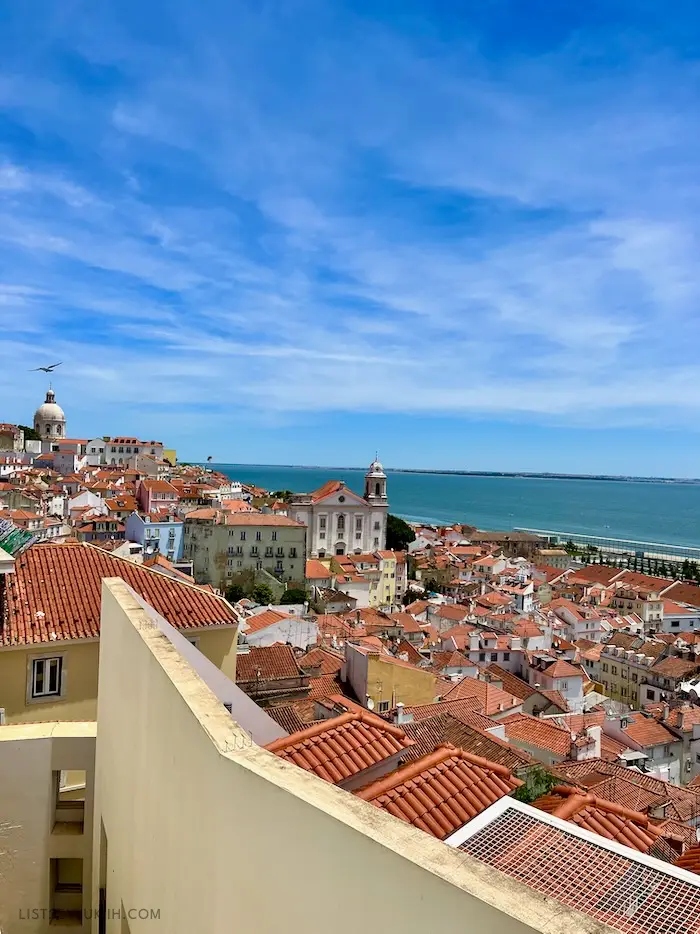
👟 Getting There: The best way to get to each miradouro will vary by location, but prepare to climb some steps or steep hills to reach all of them.
💰 Expected Cost: All viewpoints are free and are open to the public, with Miradouro Castelo de São Jorge being the exception. The castle has a €15 (roughly $16) entrance fee.
⏰ Suggested Duration: 15 to 60 minutes
🍀 Lukiih’s Take: Relaxing while looking out at the endless sea of orange clay rooftops is a very Lisbon thing to do. Given that it’s usually free and easy to find one, there’s no reason not to visit a miradouro in Lisbon.
4. Explore the City Center, Baixa-Chiado
🤔 Why: Baixa-Chiado is Lisbon’s downtown area, known as the central shopping and commercial district with notable visitor attractions. It’s one of the best places to visit if you want to see what makes Lisbon the most popular city in Portugal.
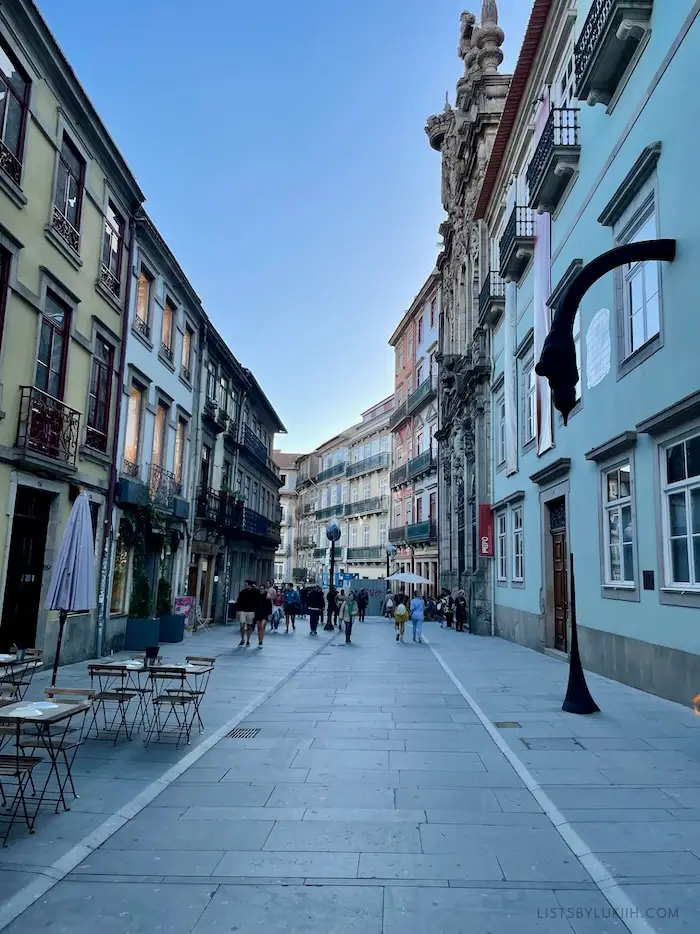
🌟 Top Attractions: Here are some of the area’s top attractions to add to your itinerary:
- Arco da Rua Augusta – a historic arch known as the gateway to Lisbon. It was originally built in 1755 to commemorate the city’s reconstruction after an earthquake destroyed most of it.
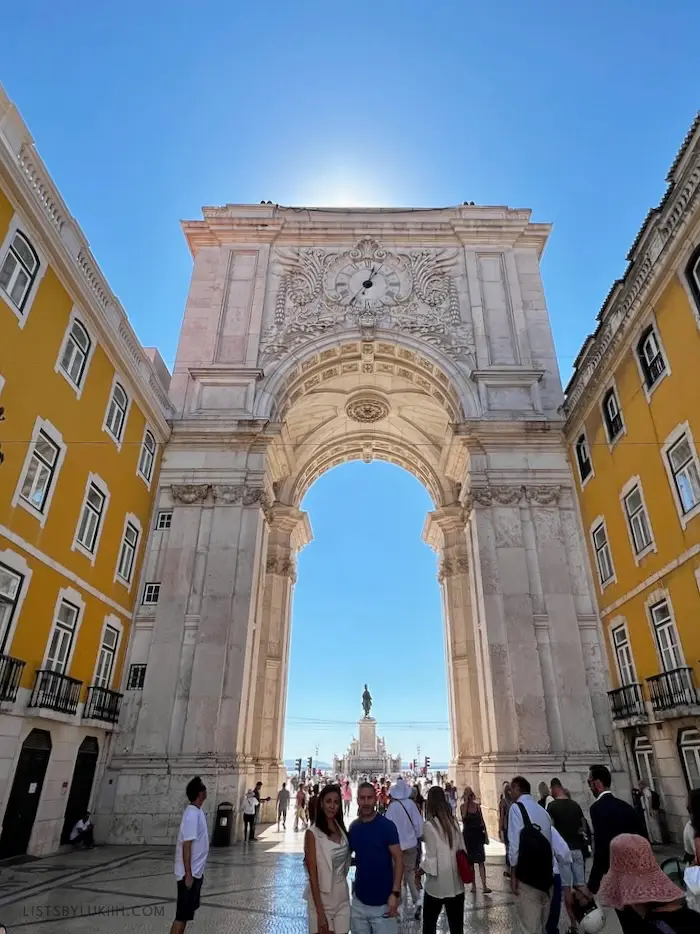
- Praça do Comércio – one of Europe’s biggest squares and a place to walk through while casually looking at art and sculptures. It’s located next to Arco da Rua Augusta.
- Carmo Convent – one of Lisbon’s most famous buildings and is sometimes referred to as the church without a roof.
- Santa Justa Lift (Elevador de Santa Justa) – one of Lisbon’s most popular and crowded attractions. It’s a beautiful elevator that stands out from the surrounding buildings.
The Santa Justa Lift is one of Lisbon’s most crowded attractions and has a $6 round-trip entrance fee.
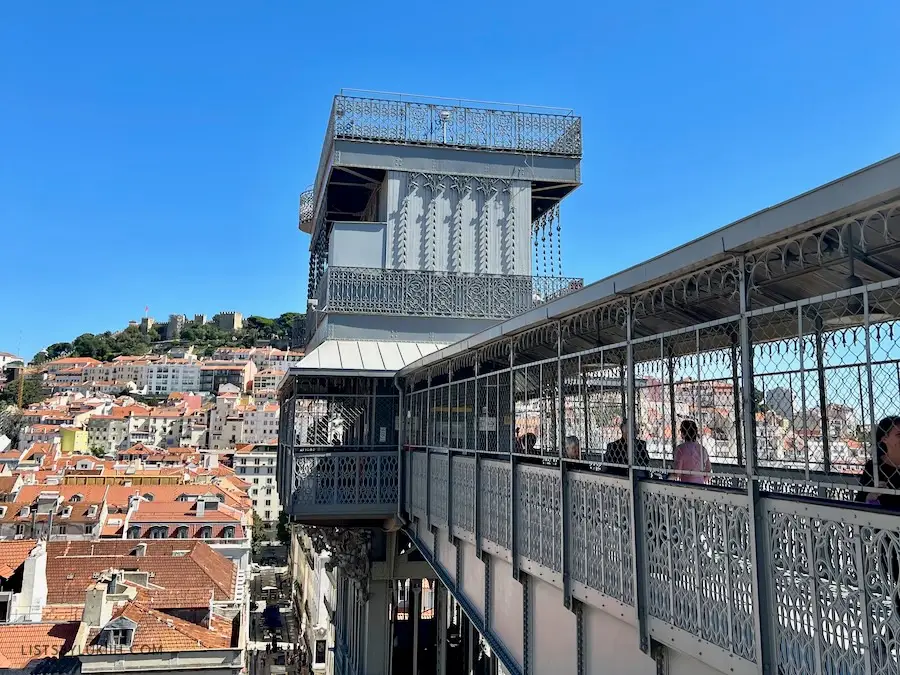
The Baida-Chiado area is also a perfect place to try some of the food that Portugal is known for. A Ginjinha is a good place to try some Portuguese cherry liqueur, and As Bifanas do Afonso has great Portuguese pork sandwiches. Santini Gelados Artesanais sells standout gelato.
💰 Expected Cost: All the attractions mentioned above are free, except for the Santa Justa Lift.
⏰ Suggested Duration: Half a day to a full day.
🍀 Lukiih’s Take: Baixa-Chiado is a great but hectic way to kick off your trip to Portugal because it offers so many things to see and do. If you need more downtime at the beginning of your trip, consider breaking up your Baixa-Chiado visit or leaving it for the second day after some rest.
5. Find Your Favorite Pastéis de Nata
🤔 Why: Pastéis de nata (custard tarts) are one of Portugal’s most well-known foods, and they were invented in Lisbon. Lisbon has several well-known stores that sell them.
🌟 Where To Go: Lisbon has over a dozen different famous pastéis de nata stores.
- Fábrica da Nata has two locations and served my favorite pastéis de nata. I found the custard, crust texture, and sweetness level perfect.

- Pastéis de Belém was my sister’s favorite pastéis de nata. They were delicious, but I liked the custard’s texture at Fábrica da Nata more.

- Manteigaria serves some of the local’s favorite pastéis de nata. I found their tart crust’s texture to be crispier and the custard to be more jello-like.
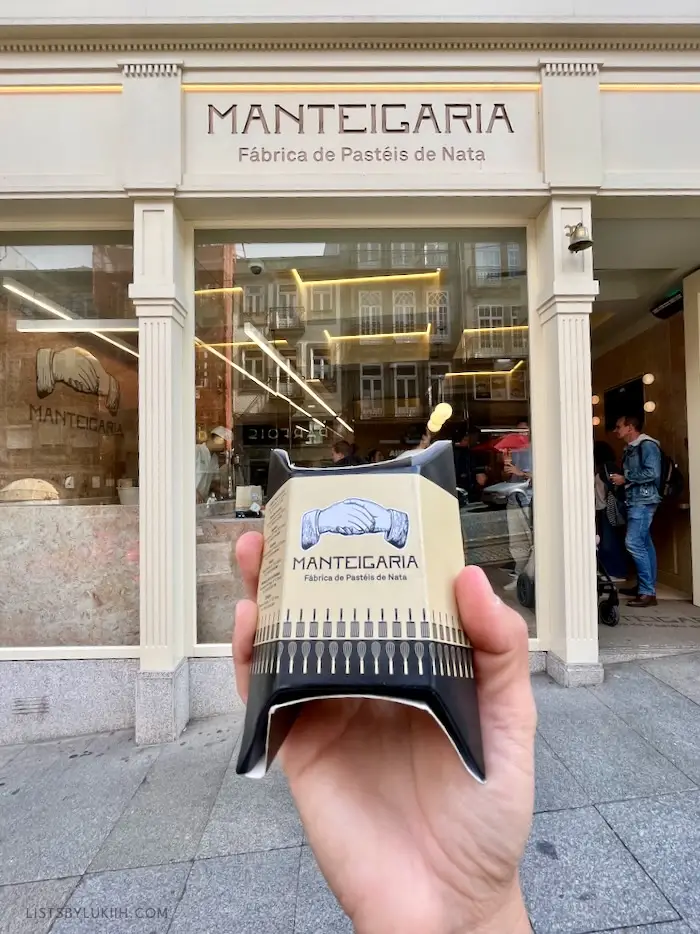
- Santo António sells award-winning pastéis de nata. Their tarts were delicious but not my favorite.
Portugal is also known for other great food, and one way to sample them without too much upfront planning is through a very well-rated Lisbon food tour.
💰 Expected Cost: The average cost of a pastel de nata in Lisbon is about $1.
⏰ Suggested Duration: You can spend as little as 10 minutes getting and eating a pastel de nata. You may have to wait in line for a bit for some of the more popular stores during meal times.
🍀 Lukiih’s Take: Although I have enjoyed Portuguese custard tarts in several countries, the pastéis de nata in Lisbon are uniquely delicious. I ate about two pastéis de nata daily and enjoyed comparing the sweetness and texture of the tarts sold by the different stores.
6. Eat and Shop at LX Factory
🤔 Why: LX Factory is a trendy complex with shops, restaurants, cafes, and art. It can be very touristy, but it also gives you the chance to see a more modern side of Lisbon.

🌟 Top Things To Do: Shop, eat, and drink your way through LX Factory. The official LX Factory site has a directory of all the stores.
LX Factory is a great place to buy souvenirs. It has stores that specialize in selling things that Portugal is known for, including corks, sardines, and ginjinha (Portuguese liqueur made from cherries.
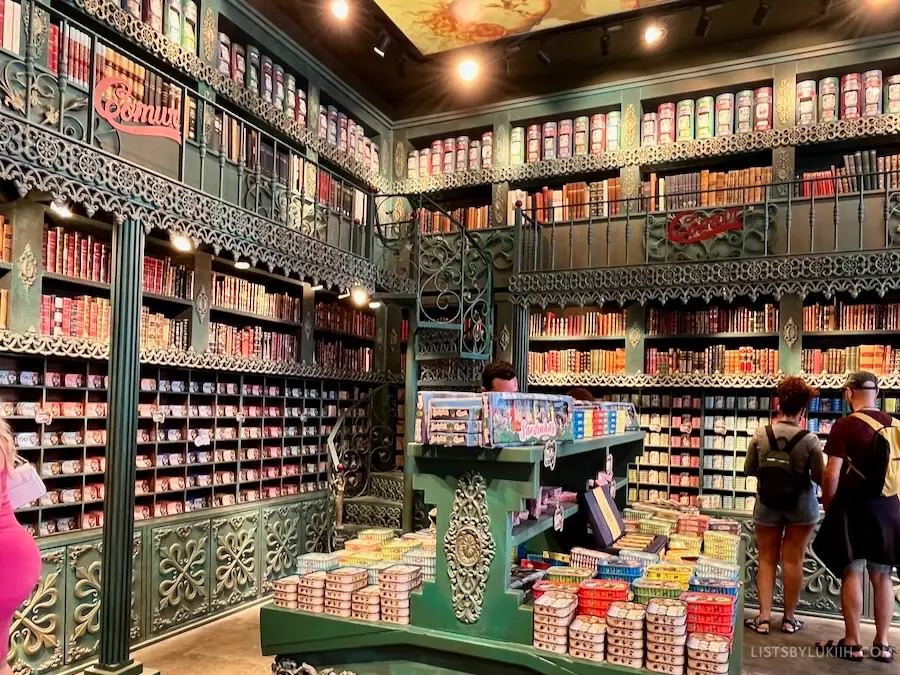
🚗 Getting There: You can get to LX Factory by train, tram, bus, or Uber. It’s about a 25 to 30-minute ride on public transport from the city center and about a 20-minute ride in an Uber.
💰 Expected Cost: LX Factory doesn’t have an entrance fee, but prepare to spend some money on souvenirs, gifts, or food there. Prices at LX Factory tend to be on the higher end since it’s a trendy location and a popular tourist attraction.
⏰ Suggested Duration: 2 to 4 hours
It’s a small area that can be completely explored on foot, so you’ll likely run out of things to see after the four-hour mark.
🍀 Lukiih’s Take: LX Factory is a great place to window shop, experience a trendy vibe in Lisbon, or visit if you want to take a break from all the city’s historic districts.
7. Eat at Time Out Market Lisboa
🤔 Why: With over 50 restaurants, bars, and shops, Time Out Market is a huge food court in Lisbon where you can find a wide variety of high-quality food.
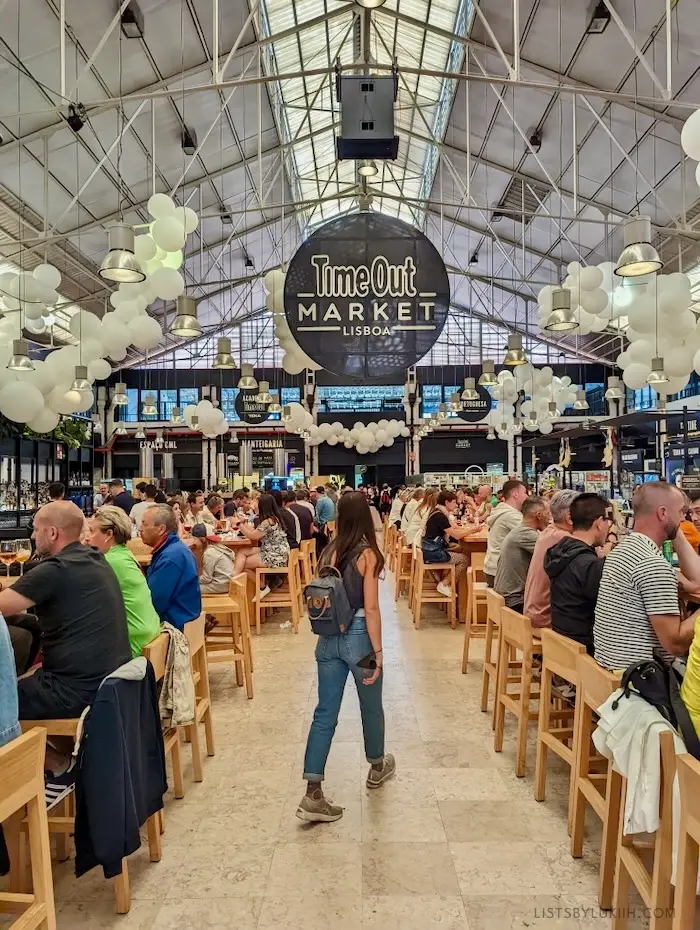
🌟 Top Things To Do: Walk around Time Out Market and see what food, dessert, or drink piques your interest.
Time Out Market is almost always crowded, so seating can be hard to find. If you’re traveling in a group, it’s best to send someone to grab seats early while everyone else orders. Otherwise, you will almost definitely have to wait for seats.
🚗 Getting There: Time Out Market Lisboa is near the city center and can be accessed by Uber, tram, bus, or metro. If you take the metro, get on the green line and take the exit at Cais do Sodré, which is a three-minute walk from the market.
💰 Expected Cost: Be prepared to spend $20 on a meal here.
⏰ Suggested Duration: 1 to 2 hours
🍀 Lukiih’s Take: Time Out Market Lisboa doesn’t necessarily feel like an authentic experience in Lisbon, but it’s a cool place to check out if you want to see an overwhelming number of food options all being offered in one location.
8. Ride a Vintage Tram
🤔 Why: A quaint and local way to explore Lisbon is by riding one of its trams. Tram #28 is the most famous tourist tram because it’s vintage and crosses many of Lisbon’s landmarks.
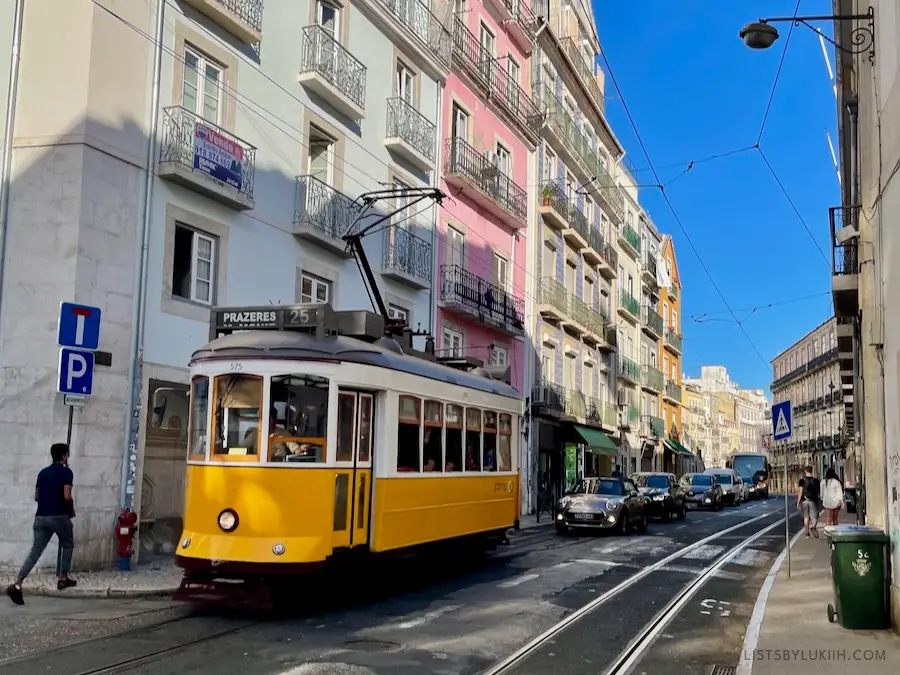
🚋 How To Ride a Tram: You can use your Viva Viagem card to pay or buy a ticket while getting on the tram. Make sure you board from the front and exit from the back of the tram.
If you’re buying a ticket on the tram, make sure you have exact change in cash, as some trams (e.g., Tram #15) do not give change.
💰 Expected Cost: A single tram ride in Lisbon costs €3 (roughly $3).
⏰ Suggested Duration: 15 to 30 minutes riding a tram.
🍀 Lukiih’s Take: Tram #28 gets extremely crowded, especially during the peak season when you might have to wait for an hour to get on board. I rode tram #15, and that was good enough for me.
9. Go To Pink Street at Night
🤔 Why: Pink Street, called Rua Nova do Carvalho, is an iconic street that becomes vibrant at night. The street is lined with bars, clubs, and restaurants that are open late into the night.
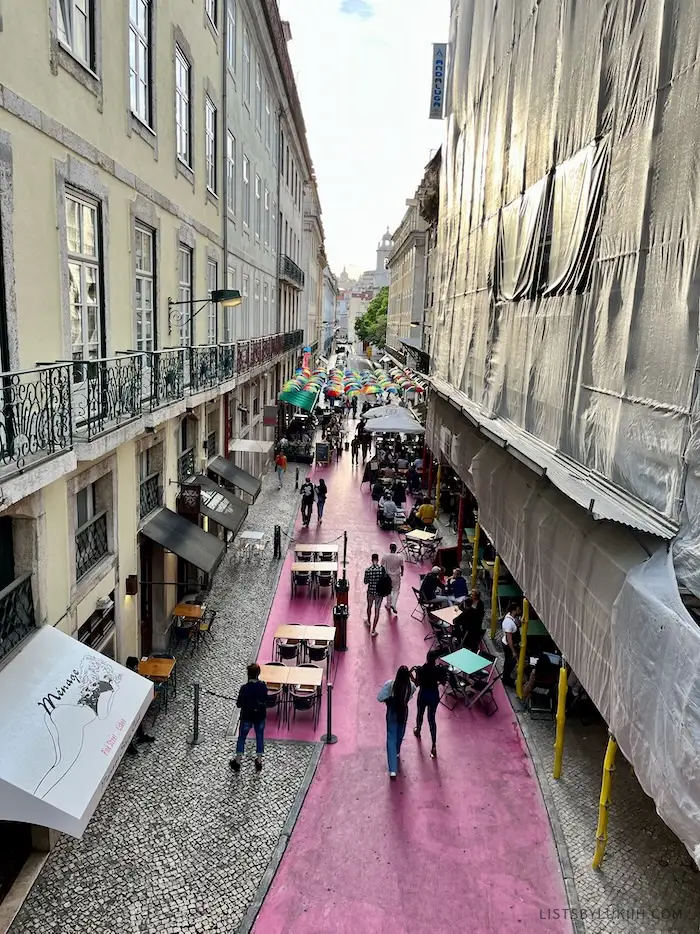
🚗 Getting There: Pink Street can be reached via Uber, metro, or tram.
💰 Expected Cost: The cost of a drink on Pink Street can vary, from as cheap as $2 for a beer to $18 for a fancy cocktail.
🍀 Lukiih’s Take: While Pink Street is great for nightlife, I found it underwhelming during the daytime. If you have five to ten minutes to spare, you can check it out for a quick photo during the daytime, but it was otherwise forgettable.
10. Check Out Bairro Alto Late at Night
🤔 Why: Bairro Alto is a historic neighborhood, and it’s also known for its vibrant nightlife, narrow streets, and lively atmosphere. Many restaurants and bars in that area don’t open until later in the day.
The scene at Bairro Alto doesn’t really start until after midnight.
🚗 Getting There: Bairro Alto can be reached via Uber, metro, or tram. Once you’re there, you can explore the area on foot.
If you arrive in Bairro Alto early, you can head north and explore Avenida da Liberdade. It’s a notable street known for its elegant architecture, high-end shopping, and theaters.
💰 Expected Cost: The cost of a drink on Pink Street can vary, from as cheap as $2 for a beer to $18 for a fancy cocktail.
🍀 Lukiih’s Take: I walked through Bairro Alto at night and found the scene to be crowded and energetic. It seemed to attract locals and tourists alike, and the area seemed like it would never go to sleep.
Where To Stay in Lisbon
Where you should stay in Lisbon depends on your interests and preferred atmosphere:
- Baixa and Chiado – These two districts are great for first-time visitors, as you’ll be close to where all the main attractions are.
- Alfama – Alfama is the perfect district for those who want a more charming atmosphere. I stayed in Alfama and loved the quieter streets with the occasional cafe.
- Belém – Belém has wider streets, is next to the river, and has more museums if that’s your cup of tea.
- Bairro Alto – For those planning to stay out late to enjoy Lisbon’s busy nightlife, Bairro Alto is a great option for where to stay.
🏠 Where I Stayed
I stayed at an Airbnb in the Alfama district for two nights and enjoyed the charming cafes around the area. It’s also within walking distance from the Santa Apolónia train station, which is convenient if you plan to go to Porto later.
I also stayed at Casas na Portuguesa in the Baixa district. The apartment has a balcony with a great view of Lisbon and the Tagus River. A mild inconvenience is that the apartment is located up a set of cobblestone stairs.

Portugal Trip Planner
To make your travel planning easier, download the trip planner below and use it as a starting point. The planner has country-specific travel information, an itinerary, a packing list, and a map with key places pinned.
The trip planner is built on Notion, which I use for all my travel planning (I genuinely love this tool). If you don’t have Notion, creating an account is free.
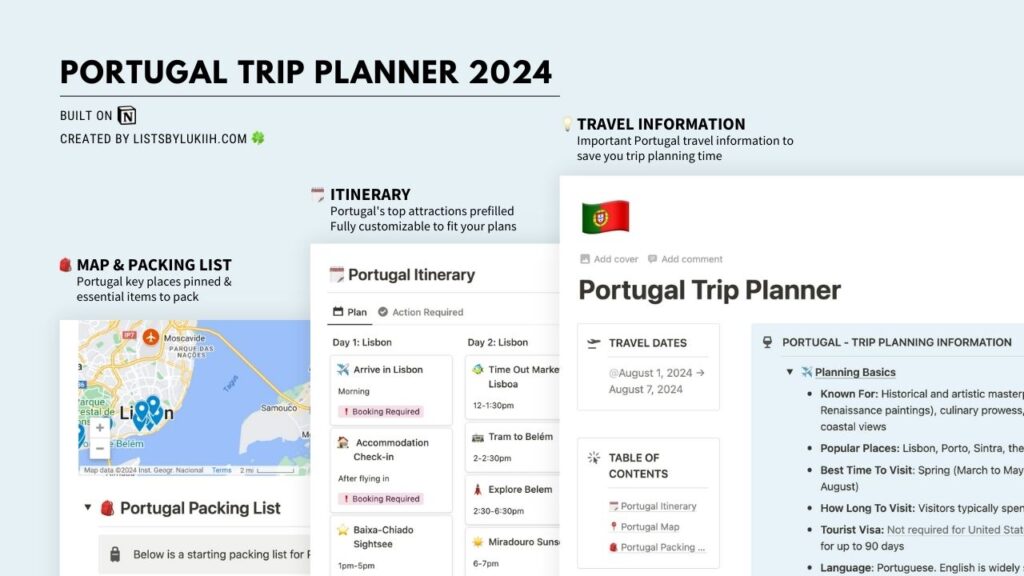
Thoughts? Questions? Leave a comment below.
Portugal Travel Guides
- 🇵🇹 Planning A Trip to Portugal: 10 Practical Things To Know
- ☀️ 7 Amazing Days in Portugal: An Efficient Itinerary
- 🏰 One Epic Day in Sintra From Lisbon: Efficient Itinerary
- ⛅ Lisbon Guide: 4-Day Itinerary + 10 Great Things To Do
- 🍷 Porto Guide: 3-Day Itinerary + 11 Top Things To Do
- 💰 My 2024 Portugal Trip Cost: A Budget Breakdown
Lists by Lukiih is Readers-Supported
If you find my travel tips helpful, say thanks with a bubble tea🧋!